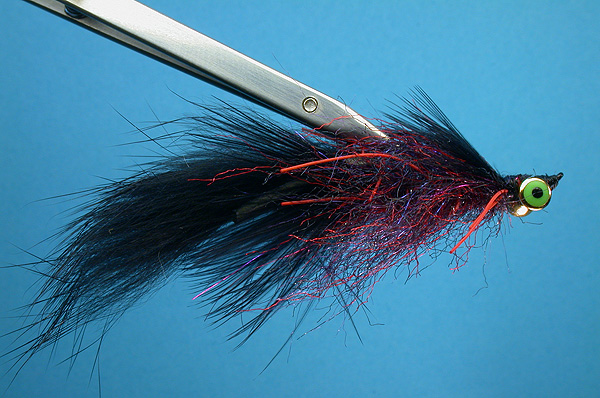Petereit Fly

Note: Brent Curtice originally created this fly design as a crawfish pattern and holds several line class records for trout with it. Curtice originally used chenille for the body. Petereit changed the body material to Enrico Puglisi's Streamer Brush with Micro legs and added the Lite Brite. This is a terrific lake pattern. Also tie this pattern using the brown or olive dubbing brush. This has lots of movement and is very life-like underwater. Due to the placement of the dumbbell eyes the hook point will ride upward. This will help keep the fly from snagging. The trigger point of this fly is the movement of the rabbit strip attached to the hook point. Tying instructions
- Start thread.
- Use figure eight thread wraps to tie in the dumbbell eyes just behind the hook eye. Add head cement to the eye wraps.
- Wrap thread back to just above the hook barb. Tie in some Lite Brite (Burgundy) and black marabou for tailing.
- At the hook bend tie in dubbing brush and wrap the tying thread back up to just behind the dumbbell eyes. Wrap the dubbing brush up to the dumbbell eyes. Stroke the dubbing brush towards the rear of the hook after each wrap. Tie off and cut dubbing brush.
- Between the hook eye and the dumbbell eyes (underside only) tie in some black marabou mixed with some burgundy Lite Brite. This acts as sort of a beard. Use thread wraps behind and in front of the dumbbell eyes. Trim at hook eye and cover wrap.
- Whip finish and head cement.
- Use dubbing brush tool to brush out and fluff the dubbing. Brush in a direction towards the rear of the fly.
- Cut a small piece of rabbit strip (1 ½ inches in length) and place it upside down on the hook point. Push this onto the hook. Hook point should puncture through the fur side 1st. The hook barb will hold this in place. The reason for placing the rabbit strip upside-down is that the fly will actually be upside down when fished.